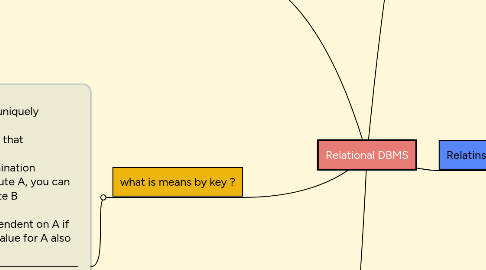
1. Relatinship between relational databse
1.1. * 1:1 relationship
1.1.1. - Should be rare in any relational database design
1.2. * 1:M relationship
1.2.1. -Relational modeling ideal -Should be the norm in any relational database design
1.3. * M:N relationships
1.3.1. - Cannot be implemented as such in the relational model - M:N relationships can be changed into 1:M relationships
1.3.2. -Implemented by breaking it up to produce a set of 1:M relationships - Avoid problems inherent to M:N relationship by creating a composite entity Includes as foreign keys the primary keys of tables to be linked
2. Right JOIN:-
2.1. Adds all the rows from the table on the left side of the join and for the rows in the right table who didn't match with any row, it gives NULL in the data entry for that row
3. relational set Operators
3.1. Relational algebra
3.1.1. Defines theoretical way of manipulating table contents using relational operators
3.1.2. Use of relational algebra operators on existing relations produces new relations
3.1.3. examples
3.1.3.1. SELECT
3.1.3.2. PROJECT
3.1.3.3. UNION
3.1.3.4. DIFFERENCE
3.1.3.5. INTERSECT
3.2. Relational Set Operators
3.2.1. Natural Join
3.2.1.1. Links tables by selecting rows with common values in common attribute(s)
3.2.2. Equijoin
3.2.2.1. Links tables on the basis of an equality condition that compares specified columns
3.2.3. Theta join
3.2.3.1. Any other comparison operator is used
3.2.4. Outer join
3.2.4.1. Matched pairs are retained, and any unmatched values in other table are left null.There are 3 types of outer joins
